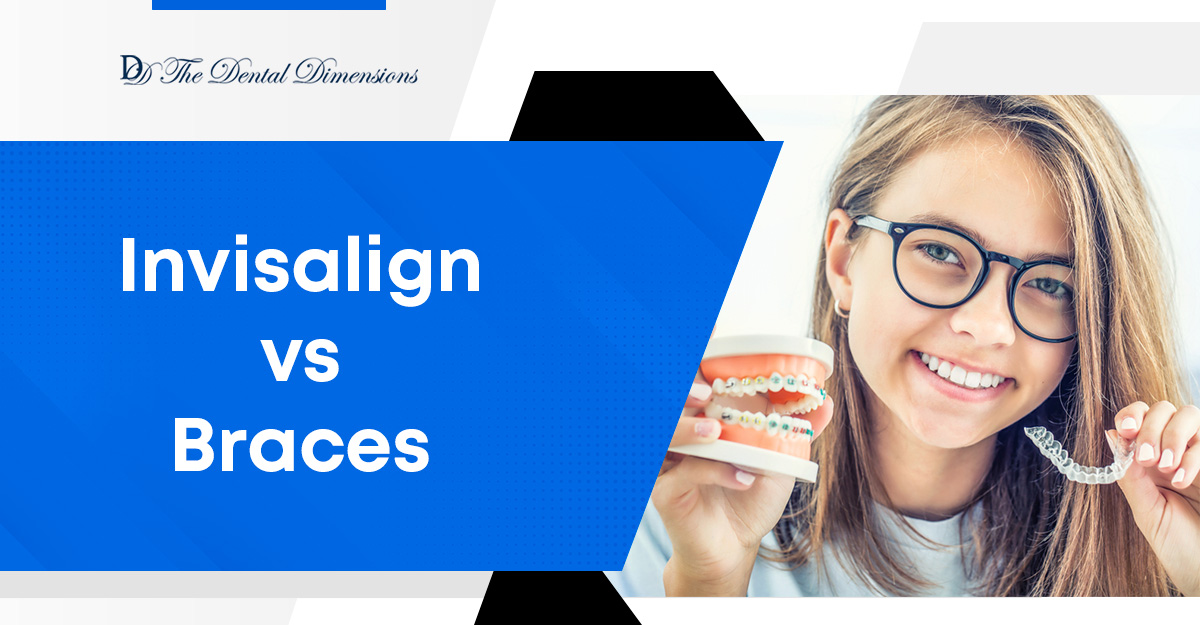Your smile is often the first thing people notice, and having a smile you’re confident in can significantly impact your self-esteem and overall well-being. If you’re looking to achieve a straighter, more aligned smile, orthodontic treatment can be a life-changing solution. However, with various options available, choosing the right one for your unique needs and preferences can be overwhelming.
This blog delves into two leading choices in the world of teeth straightening: Invisalign and traditional braces. We’ll explore their key features, advantages and disadvantages, and help you identify which option might be a better fit for your journey towards a picture-perfect smile.
Invisalign
Invisalign is a revolutionary orthodontic treatment system that utilizes a series of clear, removable aligners to gradually move your teeth into the desired position. Unlike traditional braces with metal brackets and wires, Invisalign aligners are virtually invisible, making them a discreet and aesthetically pleasing option for individuals who want to avoid the noticeable appearance of braces.
Pros of Invisalign
- Nearly invisible: The clear aligners are barely noticeable, allowing you to maintain a natural appearance throughout your treatment.
- Removable: Unlike traditional braces, Invisalign allows you to remove the aligners for eating, drinking, brushing, and flossing, making oral hygiene a breeze.
- Comfort: Invisalign aligners are known for being comfortable to wear, as they don’t irritate your gums or cheeks like traditional brackets and wires.
- Fewer appointments: Compared to braces, Invisalign may require fewer adjustments, which can save you time and hassle.
Cons of Invisalign
- Not suitable for all cases: Invisalign may not be suitable for complex misalignments or severe crowding.
- Requires discipline: You need to wear the aligners for at least 20-22 hours daily for optimal results. Failure to do so can significantly extend treatment time.
- Higher upfront cost: Invisalign treatment can be more expensive than traditional braces upfront, although the overall cost may vary depending on your individual case and insurance coverage.
Traditional Braces
Traditional braces, also known as metal braces, consist of metal brackets bonded to your teeth and connected by wires. While they might not offer the same level of discretion as Invisalign, braces have been a trusted and effective method of teeth straightening for decades.
Pros of traditional braces
- Effective for most cases: Braces can effectively correct a wide range of orthodontic issues, including complex misalignments and severe crowding.
- Consistent force: Braces apply constant pressure on your teeth, ensuring predictable and reliable results.
- Lower upfront cost: Compared to Invisalign, traditional braces generally have a lower upfront cost, making them a more budget-friendly option.
Cons of traditional braces
- Visible: The metal brackets and wires are noticeable, which may not be aesthetically pleasing for some individuals.
- Discomfort: Braces can cause discomfort and irritation, especially during the initial adjustment period.
- Food restrictions: You may need to avoid certain foods that can damage or break the brackets and wires.
- More frequent appointments: Braces typically require adjustments every 4-8 weeks, which can be time-consuming.
The Final Verdict: It’s All About You
Ultimately, the best choice between Invisalign and traditional braces depends on your individual needs, preferences, and lifestyle. Consider the following factors when making your decision:
- Severity of your misalignment: If you have complex misalignment or severe crowding, braces might be the more effective option.
- Your lifestyle: If you’re active in sports or have difficulty maintaining consistent wear, traditional braces might be a better choice due to their fixed nature.
- Your budget: While Invisalign may be more expensive upfront, consider the long-term costs, including potential additional aligners or extended treatment due to non-compliance.
- Your aesthetic preferences: If discretion is a top priority, Invisalign’s clear aligners might be the preferred choice.
Which is faster?
The speed of orthodontic treatment, whether with Invisalign or traditional braces, varies based on individual factors. For some cases, Invisalign may offer a faster treatment time, particularly for mild to moderate issues. However, the actual speed depends on factors like the complexity of the case, adherence to the treatment plan, and other individual considerations.
Remember, for a professional evaluation and personalized recommendation, schedule an appointment with a qualified orthodontist at The Dental Dimension. Our team of experts can assess your unique needs, discuss your options in detail, and answer any questions you may have, empowering you to make an informed decision towards achieving the beautiful smile you deserve.



